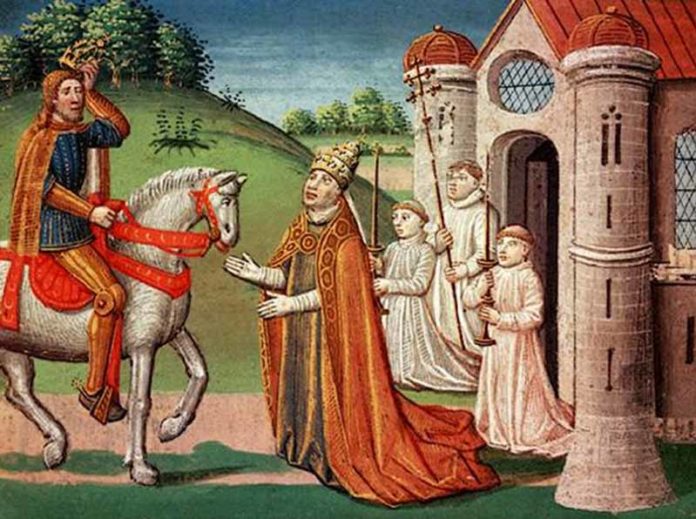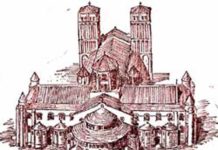
Charlemagne was the first Emperor of a united Europe, after the fall of the Romans. His legacy involved legal, writing, financial and religious reforms. His legacy is immense and his empire spanned a region closely resembling that of the founding states of the European Union, so could also be considered the creator of modern Europe.
Early Life of Charlemagne
Charlemagne was born in 742. At that time, well after the fall of Rome, Europe fell into many regions primarily dominated by a religion (in those days religion was often closely aligned to politics), a Western Christian region under the influence of Rome, many pagan areas in parts of modern Germany and Eastern Europe, an Eastern Christian region under the influence of Byzantine in modern Greece and Turkey and parts of South Italy and Venice, and an Islamic region centred in modern Spain and Portugal. His father, Pepin, had the original title Mayor of the Palace, which in practice combined the power of a prime minister with Head of the Army. Pepin was declared king of the Franks (essentially an area West of the Rhine that occupied most of modern France) in 751 to recognise his de facto power. The Pope travelled to France to do this, and Pepin was probably the first king to be anointed directly by the Pope.
Following his father’s death in 768, Charlemagne and his brother inherited his father’s lands, according to Frankish customs where domains were inherited jointly by surviving male heirs. Following his brother’s death in 771, Charlemagne became sole king of the Franks.
Military Campaigns and Christianisation
Over the next few years, Charlemagne was constantly at war, conquering much of modern Germany, also Northern Italy, and eventually extending to the entire modern French landmass incorporating modern Aquitaine. An important result of his campaigns was the Christianisation of pagan lands. He was supported by the Pope this way in that missionaries and other priests forced conversion as a form of subservience to Charlemagne. Prior to Charlemagne’s reign, Western Christianity was under severe pressure, with many competing religions, by the end of his reign it had become the dominant religion in central Europe, which it would remain.
Many kings and emperors used religion to give them legitimacy for their conquests. However Charlemagne also saw the need to improve the organisation and scholarship of the Church in his domains, and important scholars from Ireland and Britain where the Celtic Church had maintained a higher level of knowledge than in central Europe, were invited to his court. They helped design a unified script for writing and this brief period of culture when many books were written is often described as the Carolingian Renaissance. Effectively it lifted Western Europe from a somewhat barbaric culture to one where literature (at that time largely the domain of the Church) and learning were valued. This allowed Western Europe to rival Byzantium which for some centuries was the competing empire were most scholars resided.
Emperor and Legacy
Probably the defining moment of Charlemagne’s reign was his coronation as Emperor by the Pope on Christmas day in 800 in Rome. There is controversy about whether he knew this would happen or not. However this demonstrated in practice that he had restored a major unified Western Christian empire to Europe. No longer was Byzantium (the centre of the rival Eastern Empire and church) the only source of Imperial power. Charlemagne was regarded as the successor of the Western Roman Emperors, competing for legitimacy with the East.
In addition to expanding his territory, reforming the Church, developing an agreed writing system, and bringing a brief literary Renaissance to Western Europe, he introduced educational, financial and legal reforms.
He died in 814, at the age of 71. By the standards of his time he was very long lived and had had a very long reign : these combined to allow him to consolidate many changes, most kings of the time being quite short lived often then leaving their kingdom to be divided by rival siblings who fought over power and territory. By the end of his reign he had unified much of Western Europe under common leadership and culture.
Modern Europe
The remains of Charlemagne’s Empire gradually evolved into the Holy Roman Empire based in Vienna and ultimately the Austro-Hungarian Empire, whereas France evolved into a separate country. However the legacy of Charlemagne is vast.
One thing that strikes one by looking at the map of Charlemagne’s empire at the time of his death is how similar it is to the map of the founding states of the European Community in 1957. In practice all of modern France, Germany, Netherlands, Belgium and Luxemburg are incorporated. Much of Northern Italy is also part of the Empire, with only Venice left out. Switzerland, not part of the European Union, is incorporated into this Empire, but Southern Italy left out. However geographically there is a very strong correspondence between Charlemagne’s Europe of 814 AD and the original EEC. Despite over one thousand years of political divisions often into small city states and dukedoms, the region defined by Charlemagne has remained in practice a single cultural entity, forced together by these huge reforms 1,200 years ago. There is really no other imperial legacy in modern times that has been so long lasting, and profound, especially one created in practice by a single person.
Source:
- D Wilson, Charlemagne, Barbarian and Emperor, Pimlico, 2006







